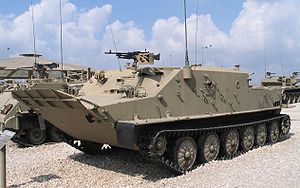BTR-50
| BTR-50 | |
|---|---|

BTR-50 PK armored transport vehicle |
|
| General properties | |
| crew | 2 (commander, driver) + 20 men |
| length | 7.07 m |
| width | 3.14 m |
| height | 2.03 m |
| Dimensions | 14.5 tons |
| Armor and armament | |
| Armor | 13 mm front, 6 mm sides |
| Main armament | Depending on the variant: 1 × oversized 14.5 mm MG of type KPWT 1 × 7.62 mm MG of type SGMB 1 × 7.62 mm PKMB -MG |
| agility | |
| drive |
Diesel engine W-6 (six-cylinder in-line engine) 240 HP (177 kW) |
| suspension | Torsion bar |
| Top speed | 44 km / h |
| Power / weight | 16.6 hp / ton |
| Range | 240 km |
The BTR-50 is a Soviet armored transport vehicle . He was in action with the land forces of the USSR and the allied states of the Warsaw Pact . As SPW-50PK , it was part of the standard equipment of the East German NVA until 1990 .
development
During the Second World War , the Red Army did not have its own armored personnel carriers. After the end of the war, experiments began on the basis of captured German transporters as well as American and British transporters acquired as part of weapons aid. Initially, large wheeled and tracked vehicles were developed, with a transport capacity of up to 30 soldiers. The BTR-50 was the first model to go into large-scale series production. Development was completed in 1952 and the vehicle was officially introduced to the Soviet military in 1954.
The disadvantages of the vehicle quickly became clear: the soldiers had to leave the vehicle via the roof hatches, it was not adapted to the size of an individual rifle squad and not suitable for use under NBC conditions and for fighting other armored vehicles. From 1966, the BMP-1 was followed by a successor model geared towards these requirements.
technology
The BTR-50 is based on the light floating tank PT-76 and uses its chassis. In contrast to all other models in the BTR series, the 50 model was equipped with chains. Two water jet openings at the stern were used for locomotion in the water.
Versions
- BTR-50P (1952): in the original version with an open crew compartment, without armament. With ramps at the stern which, when folded down, allow light guns to be loaded
- BTR-50PA (1954): with an oversized MG KPWT on the commandant 's cabin
- BTR-50PK (1958): crew compartment now with armored roof, an MG SGMB (later replaced by a PKMB )
- BTR-50PU (1959): Commander model with advanced communication technology and generator
- MTP : unarmed tow and repair vehicle
- MTK : Mine clearers
VR Poland and the former Czechoslovakia developed the OT-62 TOPAS on the basis of the BTR-50 . Syrian and Egyptian OT-62s captured by the Israeli army in the Six Day War were retrofitted with an MG FN MAG and continued to be used.
User states
BTR-50
- Afghanistan
- Albania
- Algeria
- DDR (SPW-50)
- Finland (BTR-50PK: 50)
- Guinea
- Indonesia
- Iraq
- Iran
- Congo
- Lebanon
- Romania
- Slovakia
- Somalia
- Soviet Union
- Hungary
- Vietnam